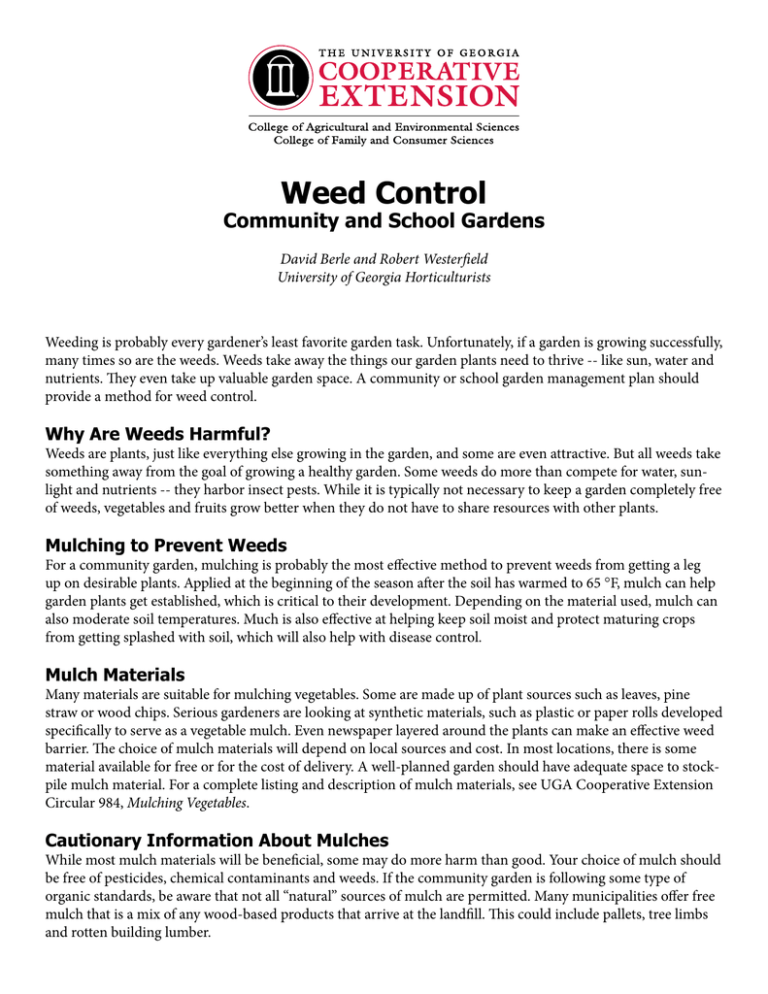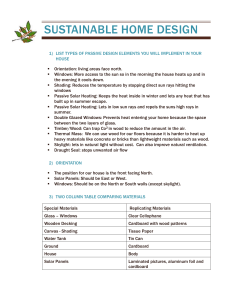Weed Control Community and School Gardens
advertisement

Weed Control Community and School Gardens David Berle and Robert Westerfield University of Georgia Horticulturists Weeding is probably every gardener’s least favorite garden task. Unfortunately, if a garden is growing successfully, many times so are the weeds. Weeds take away the things our garden plants need to thrive -- like sun, water and nutrients. They even take up valuable garden space. A community or school garden management plan should provide a method for weed control. Why Are Weeds Harmful? Weeds are plants, just like everything else growing in the garden, and some are even attractive. But all weeds take something away from the goal of growing a healthy garden. Some weeds do more than compete for water, sunlight and nutrients -- they harbor insect pests. While it is typically not necessary to keep a garden completely free of weeds, vegetables and fruits grow better when they do not have to share resources with other plants. Mulching to Prevent Weeds For a community garden, mulching is probably the most effective method to prevent weeds from getting a leg up on desirable plants. Applied at the beginning of the season after the soil has warmed to 65 °F, mulch can help garden plants get established, which is critical to their development. Depending on the material used, mulch can also moderate soil temperatures. Much is also effective at helping keep soil moist and protect maturing crops from getting splashed with soil, which will also help with disease control. Mulch Materials Many materials are suitable for mulching vegetables. Some are made up of plant sources such as leaves, pine straw or wood chips. Serious gardeners are looking at synthetic materials, such as plastic or paper rolls developed specifically to serve as a vegetable mulch. Even newspaper layered around the plants can make an effective weed barrier. The choice of mulch materials will depend on local sources and cost. In most locations, there is some material available for free or for the cost of delivery. A well-planned garden should have adequate space to stockpile mulch material. For a complete listing and description of mulch materials, see UGA Cooperative Extension Circular 984, Mulching Vegetables. Cautionary Information About Mulches While most mulch materials will be beneficial, some may do more harm than good. Your choice of mulch should be free of pesticides, chemical contaminants and weeds. If the community garden is following some type of organic standards, be aware that not all “natural” sources of mulch are permitted. Many municipalities offer free mulch that is a mix of any wood-based products that arrive at the landfill. This could include pallets, tree limbs and rotten building lumber. Wood chips can be a great source of free mulch; however, fresh wood chips can have one major drawback: there is evidence that some species of trees -- not just black walnut -- have compounds in the wood that can inhibit germination of some seed. Because wood chips from yard waste may come from a variety of trees with an unknown origin, it is best to limit the use of wood chips to walkways and row middles and avoid applying them directly around vegetable crops unless the material has been aged or composted first. Overcrowding Many first-time gardeners plant too many seeds and are too timid about thinning. Overcrowding from other vegetables can be just as much of a problem as weeds. It is important to follow recommended plant spacing in the garden. Plants that are too close together compete for resources just like weeds. Plants spaced too far apart leave room for weeds to grow. Proper spacing is especially important for fruit plants since the spacing decision is more permanent than with vegetables. Circular 1027-13 February 2013 The University of Georgia and Ft. Valley State University, the U.S. Department of Agriculture and counties of the state cooperating. Cooperative Extension, the University of Georgia College of Agricultural and Environmental Sciences, offers educational programs, assistance and materials to all people without regard to race, color, national origin, age, gender or disability. The University of Georgia is committed to principles of equal opportunity and affirmative action.




